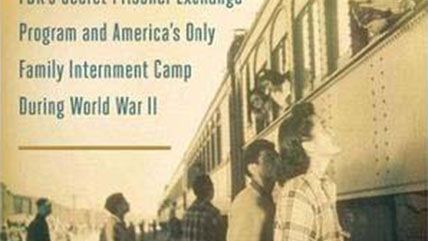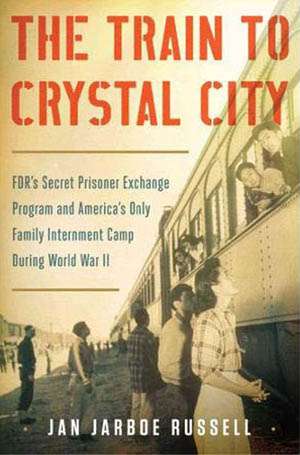America's Other World War II Internment Camps
The legacy of the German and Japanese prisoners held hostage

The Train to Crystal City: FDR's Secret Prisoner Exchange Program and America's Only Family Internment Camp During World War II, by Jan Jarboe Russell, Scribner, 432 pages, $18

Most Americans are aware of the War Relocation Authority camps established after the Japanese attack on Pearl Harbor. That program rounded up and interned 120,000 people of Japanese ancestry, more than half of them born in the United States. Less well known is the Alien Enemy Control Unit program, which scooped up other Japanese Americans, along with German and Italian Americans that the Justice Department considered national security threats, often on the flimsiest of evidence.
The Alien Enemy Control Unit camp in Crystal City, Texas, was the program's only detention center specifically designed to accommodate families. It is the focus of The Train to Crystal City, the Texas-based journalist Jan Jarboe Russell's painful account of the Americans held in captivity and used as hostages to recover other Americans held abroad during World War II.
Like so much else associated with overweening government, the family relocations were launched with something resembling good intentions: to let family members live with their already detained parents and spouses. But the incarcerations of sons, daughters, and wives simply added to the human toll of what was already an unjust and unjustifiable system.
In the days immediately after Pearl Harbor, President Franklin Delano Roosevelt set in motion a chain of events that would wreck tens of thousands of lives while providing scant return in terms of national security.
Attorney General Francis Biddle later wrote, "I do not think Roosevelt was much concerned with the gravity or implications of this step." In fact, the president had been contemplating such a step for years, long before the United States entered World War II. On September 1, 1939, the day Germany invaded Poland, Roosevelt ordered the creation of a top secret Special Division within the State Department. Its task: to catalog important Americans living in Germany and Japan. A few months later, he authorized the Special War Problems Division to identify Japanese and Germans in the United States and Latin America who could be used as trade bait for those Americans.
The government was therefore able, within days of Pearl Harbor, to take 1,212 Japanese, 620 Germans, and 98 Italians into custody. Many, many more would follow. When FDR asked Biddle how many Germans were in the country, Biddle told him there were about 600,000. "And you're going to intern all of them," Roosevelt replied.
They didn't intern all of them. But on February 19, 1942—just 74 days after Pearl Harbor—FDR signed the notorious Executive Order 9006, condemning Japanese, Germans, and Italians to forced removals from "military zones." The legal underpinning for the human disaster that followed was now in place. The War Relocation Authority, formed on March 18, 1942, operated in regions designated Military Areas 1 and 2, covering California, Oregon, Washington, and Arizona. The Alien Enemy Control Unit, created soon after in the Department of Justice, ran Crystal City and operated branches in each federal judicial district, where Alien Enemy Hearing Boards determined who would be interned.
While tens of thousands of Americans were sent to the camps, the reach of the program extended beyond the U.S. border via the Emergency Advisory Committee for Political Defense, a multi-national arrangement run by the State Department that worked with Latin American nations to find and detain enemy aliens. Peru, for example, deported 1,799 Japanese, 702 Germans, and 49 Italians to the United States. In total, 4,058 Germans, 2,264 Japanese, and 288 Italians from 13 Latin American countries were sent to the U.S.; many ended up at Crystal City.
As was often the case in California and other Western states, there was more at work in the Latin American deportations than a concern for national security, or even overt racism. "In return for delivering Axis nationals to the United States," Russell writes, "the governments seized their homes, businesses and bank accounts." Deportation could be a money-making proposition.
Russell's narrative is framed by the stories of two young women, one German, one Japanese.
Ingrid Eiserloh and Sumi Utsushigawa, who followed their fathers into custody, became part of the "Quiet Passage" prisoner-exchange program, in which prisoners held at Crystal City were traded for Americans held in Germany and Japan. Ostensibly, the program sent enemy aliens "home." In reality, as with both Eiserloh and Utsushigawa, they often were sent to countries they had never seen in their lives.
Until then, they were interned at the 290-acre camp. This settlement stood in a dusty no-man's land, which detainees reached after interminable rides aboard dark trains. The camp itself was no more welcoming. "Guards with long rifles were positioned in six guard towers," Russell writes. "At night, the searchlights from the camp could be seen across the border in Mexico."
Barbed wire rimmed the camp, situated in the trackless South Texas desert with virtually no paved roads, few amenities of civilization, and long stretches of sand and sage.
Sumi Utsushigawa's father, Tokiji, a photographer and owner of the apartment building in which his family lived, was first taken to the Santa Fe Internment Camp. No explanation for his arrest was ever given. Others in his building had been taken away before him. One was a woman who had entertained members of the Japanese navy who were visiting the United States. Others, Russell writes, were arrested "for having feudal dolls or playing Japanese music."
Sumi and her mother were sent to the Heart Mountain camp in Wyoming. Within a year, the two women were selected to be part of a prisoner exchange that would free more than 1,300 Americans being held by Japan. But the numbers didn't match up, and nearly 100 of the Japanese Americans were taken out of line, Sumi and her mother among them.
In a dark irony, they were then sent to Ellis Island, that beacon of hope for immigrants coming to America. After a short stay there, they were brought to Crystal City via train and reunited with Sumi's father, who had been moved there from Santa Fe. After two years, the Utsushigawas were sent to Japan, where the Los Angeles–born Sumi had never lived.
Ingrid Eiserloh was born in New York and lived in Strongsville, Ohio. Her father, a German immigrant named Mathias, was arrested a month after Pearl Harbor. Again, no reason was given. When two FBI agents came to his door, they seized an address book containing the names and addresses of other German legal aliens, a list of shortwave German radio programs, and some personal effects.
He was a legal resident, and he showed the agents his alien ID card. "No charges were filed," Russell recounts, "and he would never be convicted of any crime." Nevertheless, Mathias Eiserloh did not see his family for a year and a half, until they were reunited at Crystal City. They stayed there for another 18 months before they were selected to be part of a prisoner exchange with Germany.
The full story of that exchange is at once so heartbreaking and so uplifting I won't spoil it here. Suffice to say that events transpired that would alter the lives of hundreds of people—including 565 American POWs—even more desperate than the Eiserlohs and the Utsushigawas.
Members of both families got jobs at U.S. military installations in their new countries. Ingrid Eiserloh and Sumi Utsushigawa would eventually make their way back to the United States.
The Crystal City camp remained a going concern for almost three years after the war ended in 1945. Trapped behind barbed wire, with armed guards still standing sentry, the few remaining prisoners were a problem nobody in the government seemed to know how to solve. Some countries, such as Peru, did not want their detainees returned. The children of German-born detainees did not want to be shipped to Germany. The camp finally closed in February 1948, after the final prisoners were released.
Forty years later, President Ronald Reagan issued a formal apology to the Japanese and Japanese Americans sent to detention camps, and $37 million was made available by Congress to pay restitution. But no apology and no payments have come for Germans and Italians placed in the same straits.
While The Train to Crystal City is a marvelous accomplishment, it does contain several small errors of fact. Russell writes that no one read Mathias Eiserloh his rights "because as a legal resident alien…Eiserloh had no rights under US laws." This was 20 years before Miranda v. Arizona; very few people, citizens or not, were getting their rights read to them in 1942. She also refers to the Japanese tea ceremony as a "tea service," calls Secretary of War Henry L. Stimson "Stinson," and describes the robust and newlywed 1916 version of Woodrow Wilson as "a frail elderly man." Taken as a whole, though, such shortcomings are far outweighed by the blistering indictment delivered by Russell's reportage.
Publishers love authors to "bring the story into the present day," and one reviewer wrote of "obvious parallels between Crystal City and today's Guantanamo Bay detention facility." Russell mostly resists this temptation, though an afterword to the paperback edition claims that the "climate of fear" and the "trauma of war" are "as real today as they were in 1942." That's an exaggeration: While some Guantanamo prisoners were not guilty of being enemy combatants, no Japanese American or Japanese national living in the U.S. was ever convicted of espionage or sabotage.
In any event, this story needs no links to the modern day to give it impact. It is the painful tale of government run amok—and of how, against all odds, at least in some small way the human spirit triumphed over the injustice.
This article originally appeared in print under the headline "America's Other World War II Internment Camps."


Show Comments (253)